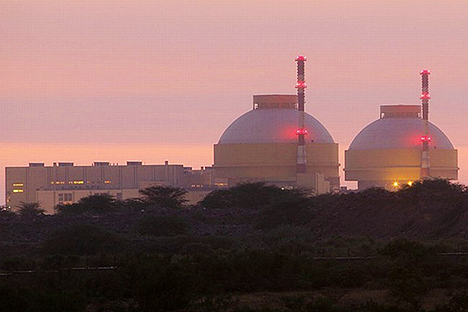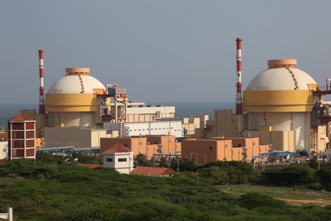Indian Supreme Court gives green signal to Kudankulam plant

The court observed that nuclear energy is extremely important for the country's growth and a balance has to be struck between the right to life and sustainable development. Source: Press Photo
The Indian Supreme Court on Monday gave its much-awaited clearance for the Kudankulam Nuclear Power Plant project (KNPP) in THE southern Indian state of Tamil Nadu being built with Russian help. Today’s judgment has come on the 630th day of Protests over the alleged not-up-to-the-mark safety features of the plant.
However, the court, while disposing of a public suit which sought the court’s direction to halt the commissioning of the plant on safety concerns, attached a rider. The court cautioned the Indian government and the KNPP’s operator Nuclear Power Corporation of India Ltd (NPCIL) to find safe areas to dispose of the nuclear waste which the plant would be generating. “Don’t commission the plant before final report on safety aspect is out,” the Supreme Court expressly directed in its judgment.
Why it is Good News for the Russians
Significantly, the Indian Supreme Court’s decision has come close on the heels of an admission by India’s Atomic Energy Regulatory Board (AERB) that four valves in the first reactor of the project were faulty.
New Delhi and Moscow had been waiting to see how the Indian Supreme Court deals with the Kudankulam case where public concerns about the nuclear plant’s safety became an overriding concern – not just of the petitioners but a large number of people living near the KNPP site. These concerns had become all the more vociferous after the March 11, 2011 nuclear disaster involving Japan’s Fukushima plant.
A Green Light and a Yellow Light
The Indian Supreme Court’s judgment has given a green light to the KNPP project but has also made it clear that a yellow light is also flickering which can turn into red if the project handlers let things go awry on safety aspects.
While giving its nod to the commissioning of the Kudankulam plant, the court said it was set up for the welfare and sustainable growth of the people of India and added: “Kudankulam plant is safe and secure and it is necessary for larger public interest and economic growth of the country.” The court also observed that nuclear energy is extremely important for the country's growth and a balance has to be struck between the right to life and sustainable development.
What should gladden the hearts of the Indian and Russian governments further is that the Indian Supreme Court noted that various expert groups have opined that there would be no impact on the life around the plant because of radiation. Justice Dipak Misra, one of the two judges who gave the judgment (the other judge being Justice KS Radhakrishnan), said the larger public interest should prevail over the minor inconveniences that may be caused to the people. Misra concurred with the directions and the commissioning of the plant.
This is the green light.
Having said that, things won’t be easy for the Indo-Russian project handlers as the Supreme Court is keeping hawkish eye on the safety aspects of the plant. Any small mishap would inevitably catch the court’s attention and complicate matters. The Supreme Court has issued 15 guidelines on commissioning, safety and security and environmental issues concerning the Kudankulam plant.
This is the yellow light.
Anti-nuclear activists had filed a bunch of petitions before the Supreme Court raising security and environmental concerns as well as the safety features of the Kudankulam plant in the event of a major earthquake or tsunami or a terrorist attack. The Indian government and the NPCIL had assured the court that the plant had a state-of-the-art multi-layered safety mechanism. They submitted to the court during the three-month long marathon hearings earlier this year that the Kudankulam plant is completely safe and can withstand any kind of natural disaster and external terrorist attack.
The NPCIL, in a sworn affidavit to the Supreme Court, had even gone on record extolling the expertise of the Russian technicians who are working on the plant.
Related:
Russian expert vouches for Kudankulam safety
Kudankulam plant passes stress, endurance tests
Kudankulam: Suspicious money transfer made to activist from London
Petitioner’s objections to ‘sub-standard’ equipment from Russian company
Chennai-based IT professional G Sunderrajan, one of the important petitioners in the case, had raised concerns about what he alleged the use of “sub-standard equipment” from the Russian company Zio-Podolsk and asked the court to ensure that this is not done.
It is not immediately known how the court has dealt with this specific grievance of Sunderrajan. Officers involved in the case said the judgment will have to be studied thoroughly before answering this question.
The Indian government has already trashed all objections raised by Sunderrajan, who had pleaded for a court directive that a proper mock drill is conducted for the safety of the people living within the 25-km radius of the KNPP and that the government first implements 11 of the 17 additional safety measures recommended for the nuclear plant by a task force set up by the government in the wake of Fukushima nuclear disaster. The government’s argument is that those are just enhanced safety features that would be implemented in due course.
What Next?
With the Supreme Court’s favourable verdict, now the ball is in the court of the AERB. The first unit of the two KNPP units of 1000 MW each being built with Russian help is ready for commissioning subject to the AERB’s final clearance to the NPCIL. The AERB determination in the matter is likely to be conveyed to the NPCIL next week.
The writer is a New Delhi-based journalist-author who has reported extensively on nuclear-related issues.
All rights reserved by Rossiyskaya Gazeta.
Subscribe
to our newsletter!
Get the week's best stories straight to your inbox
